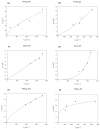Adsorption Technology for PFAS Removal in Water: Comparison between Novel Carbonaceous Materials
- PMID: 39274559
- PMCID: PMC11395723
- DOI: 10.3390/ma17174169
Adsorption Technology for PFAS Removal in Water: Comparison between Novel Carbonaceous Materials
Abstract
PFASs are a variety of ecologically persistent compounds of anthropogenic origin loosely included in many industrial products. In these, the carbon chain can be fully (perfluoroalkyl substances) or partially (polyfluoroalkyl substances) fluorinated. Their ubiquitous presence in many environmental compartments over the years and their long-lasting nature have given rise to concerns about the possible adverse effects of PFASs on ecosystems and human health. Among a number of remediation technologies, adsorption has been demonstrated to be a manageable and cost-effective method for the removal of PFASs in aqueous media. This study tested two novel and eco-friendly adsorbents (pinewood and date seeds biochar) on six different PFASs (PFOS, GenX, PFHxA, PFOA, PFDA, and PFTeDA). Batch sorption tests (24 h) were carried out to evaluate the removal efficiency of each PFAS substance in relation to the two biochars. All samples of liquid phase were analyzed by a developed and then a well-established method: (i) pre-treatment (centrifugation and filtration) and (ii) determination by high-performance liquid chromatography coupled with mass spectrometry (HPLC-MS/MS). The results evidenced a comparable adsorption capacity in both materials but greater in the long-chain PFASs. Such findings may lead to a promising path towards the use of waste-origin materials in the PFAS remediation field.
Keywords: PFASs; adsorption technology; date seeds biochar; pinewood biochar; water treatments.
Conflict of interest statement
The authors declare no conflicts of interest.
Figures






References
-
- European Chemical Agency (ECHA) [(accessed on 1 July 2024)]. Available online: https://echa.europa.eu/hot-topics/perfluoroalkyl-chemicals-pfas.
-
- National Institute of Environmental Health Sciences NIEHS Perfluoroalkyl and Polyfluoroalkyl Substances (PFAS) [(accessed on 4 July 2024)]; Available online: https://www.niehs.nih.gov/health/topics/agents/pfc/index.cfm#footnote.
-
- Fenton S.E., Ducatman A., Boobis A., DeWitt J.C., Lau C., Ng C., Smith J.S., Roberts S.M. Per- and Polyfluoroalkyl Substance Toxicity and Human Health Review: Current State of Knowledge and Strategies for Informing Future Research. Environ. Toxicol. Chem. 2021;40:606–630. doi: 10.1002/etc.4890. - DOI - PMC - PubMed
Grants and funding
LinkOut - more resources
Full Text Sources

